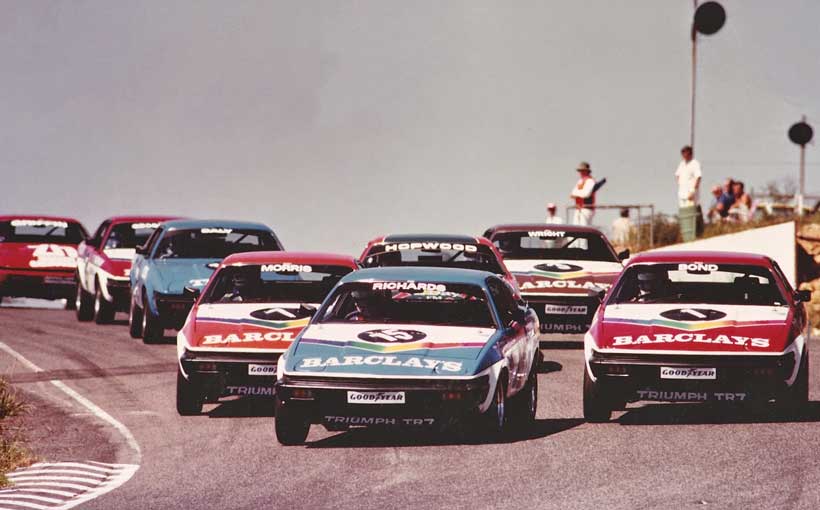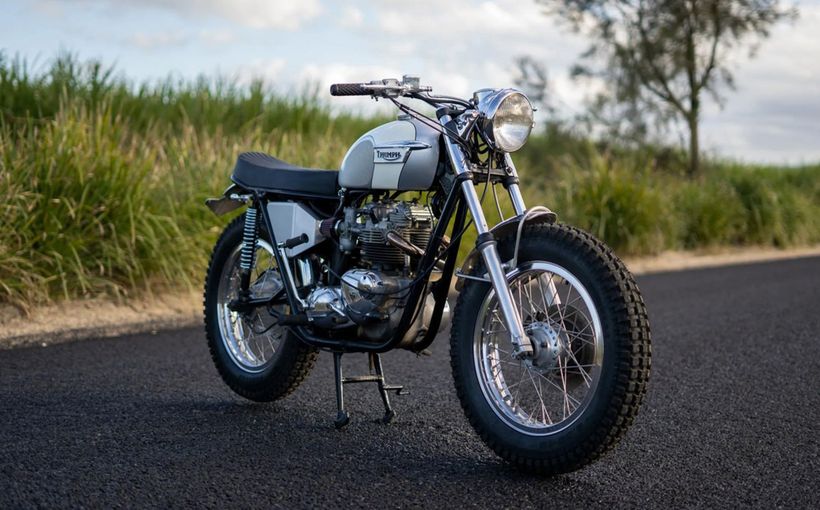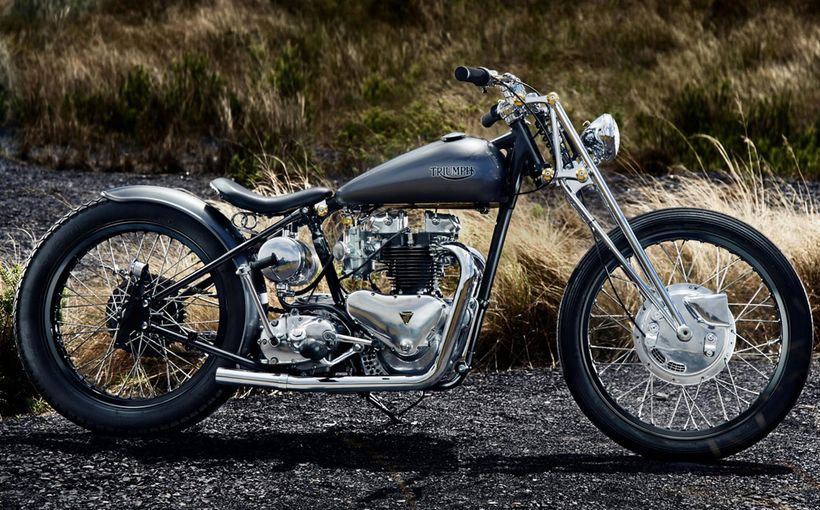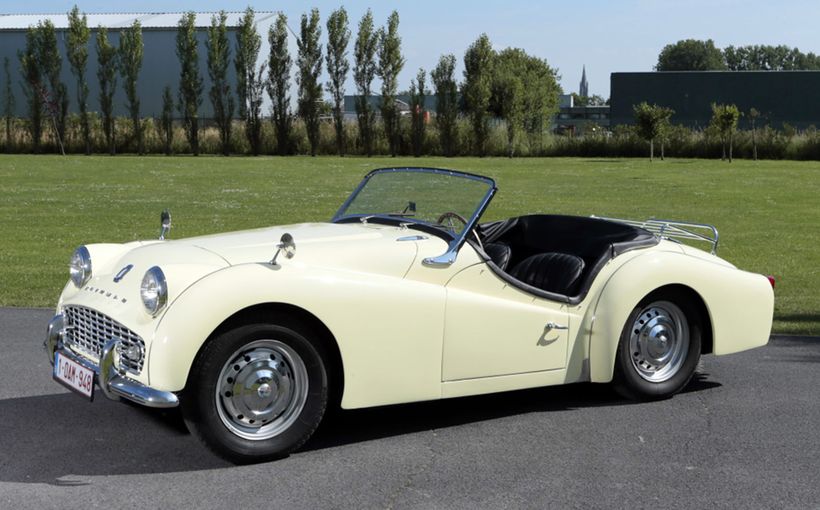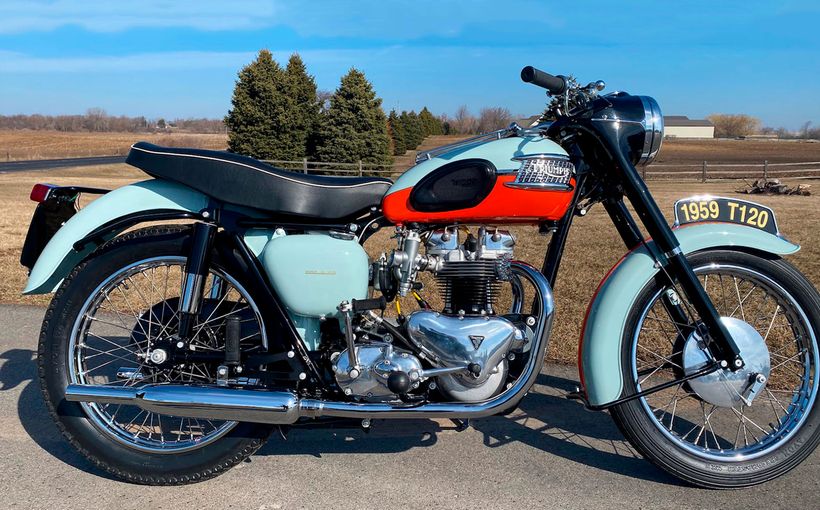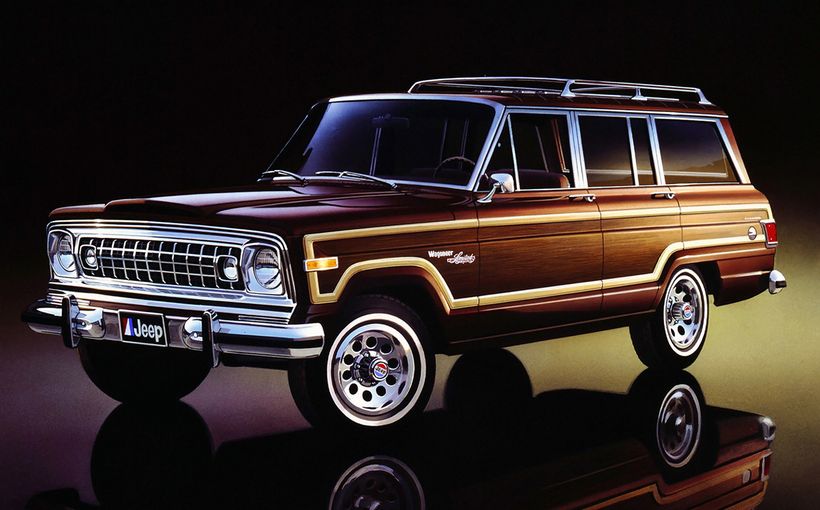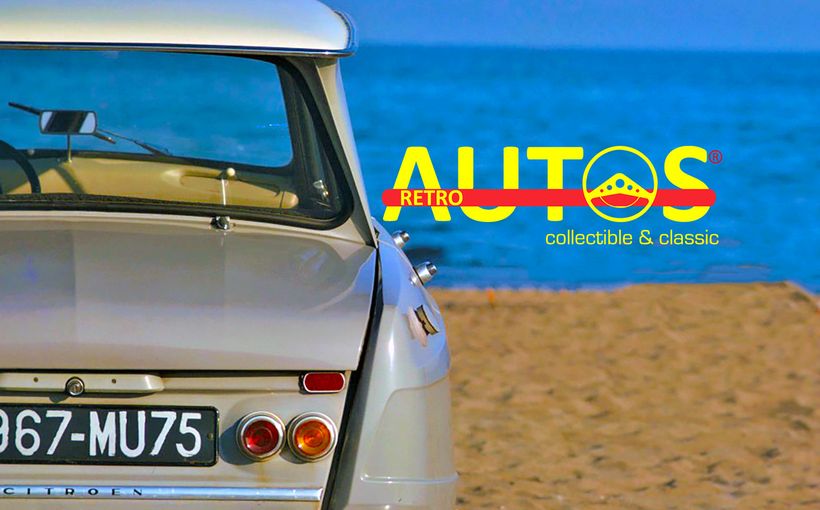Triumph TR7: How a troubled British sports car became an Aussie racing star!

A pack of identical Triumph TR7s driven by some of Australia’s top touring car drivers at Amaroo Park was guaranteed to provide plenty of entertainment. Jim Richards, Colin Bond and Bob Morris lead the field over the top of Bitupave Hill in the 1981 Barclays TR7 Pro-Am Series. Image: www.drivingandlife.com
For a car manufacturer, the best thing about backing a one-make series is that your car wins every race! Back in the early 1980s, Leyland Australia used this simple but effective strategy to boost the appeal of its troubled Triumph TR7 sports car and quickly turned a slow-seller into a sell-out.
The Barclays TR7 Pro-Car Series (and Pro-Am Series which followed) was the brainchild of Leyland Australia’s marketing and PR departments, which were looking for the most cost-effective way to boost sales of the TR7.
Launched locally in 1978, the TR7 initially struggled to find buyers in Australia. People were confused by its combination of dramatic wedge-shaped styling with a stumpy squared-off tail and hardtop roof. It was such a departure from the TR’s well-defined ‘rag top’ heritage that the line between a traditional British sports car and a two-seater sedan or GT had become blurred.
However, beyond its polarising looks and atrocious UK build quality, the TR7 had other attributes which suggested it was at least worthy of consideration by drivers that liked cars with a sporting edge - or ‘wedge’ in this case.

Bob Morris and Jim Richards were the toughest drivers to beat. In the first Pro-Car Series held in 1980, they were the only drivers to take the chequered flag in the five races held. Here the leading protagonists are locked in a typically close fight for the lead in a 1981 race.
Boasting an agile kerb weight of around 1000 kg, the TR7’s 2.0 litre two-valve four cylinder engine (78 KW/161 Nm) was mated to a five-speed gearbox. This was barely enough to explore the limits of a delightfully responsive and well-balanced chassis, based on a compact 85-inch (2159mm) wheelbase with MacPherson front struts, multi-link coil-sprung live rear axle, rack-and-pinion steering and front disc brakes.
Buyer resistance to the new TR was strong, particularly amongst Triumph traditionalists, with a widespread misunderstanding of the new model. It’s claimed that some Triumph car clubs initially would not even accept TR7 owners as new members.
Clearly Leyland Australia had a big problem which would require thinking outside the square to boost the TR7’s credibility as a genuine sports car and fire up some showroom traffic. The most effective way to do that was through the time-honoured tradition of motor sport, but it took several throws of the dart before the company hit the bulls-eye.

Leyland Australia’s first attempt to promote the new TR7 through motor sport came with the purchase of a Bob Tullius/Group 44 ex-works car from the US, which competed in the 1978 Australian Sports Car Championship. Although the talented Bill Evans won the 2.0 litre class, the result hardly set the world on fire.
If at first you don’t succeed…
On reflection, you would have to give Leyland Australia an ‘A’ for effort when faced with the formidable challenge of trying to turn its trouble British sports car into the most unlikely of local track stars and sales successes.
The first attempt came in 1977 when the company bought the ex-works TR7 which had been built and raced successfully in US sports car racing by Bob Tullius and his Group 44 team. The plan was for multiple Bathurst class winner ‘Wild’ Bill Evans to drive it in the 1978 Australian Sports Car Championship, in a team backed by Penthouse magazine.
The lightweight factory racer, turned out in a new black livery, was upgraded with a more powerful 16-valve Dolomite engine, five-speed close-ratio gearbox and stronger rear end for the ASCC campaign.
Evans did the best he could against more powerful competition. Although he was never in a position to win a race outright, he did win the 2.0 litre division and finished second overall in the championship beaten only by a Porsche 911.

In 1979 Leyland Australia considered a factory-backed TR7 rally attack, firstly powered by a locally turbocharged version of the standard 2.0 litre four and later with one of the 3.5 litre aluminium Rover V8s used in the rare UK-built rally cars. Although the program did not proceed, multiple rally champ Colin Bond did build his own version of the TR7 V8 in 1982, fitted with a 4.4 litre P76 V8. It was blindingly fast and the forest crowds adored its rocky-throwing thunder, but the British car’s outings were sporadic at best and its career in Bondy’s hands all too brief. Image: Chevron Publishing
Although the ex-Group 44 TR7 had proven to be consistent, it hardly set local buyer pulses racing in a national sports car contest that received poor media coverage and was clearly in its dying days. The ASCC program was aborted after one year.
For 1979 Leyland Australia changed its strategy, with UK parent British Leyland providing a budget to install turbochargers on all local stocks of unsold TR7s to make them more appealing to buyers. It was decided that this bold initiative would be promoted through rallying, which the British HQ was also doing at the time with a TR7 ‘homologation special’ fitted with the Rover 3.5 litre aluminium V8.
Despite Leyland Australia’s best intentions the proposed TR7 turbocharger retro-fit and rally program also had to be abandoned before it started, as the costs involved far outweighed the benefits. So after two years and with little to show for it, Leyland Australia really needed to come up with a winning solution for 1980.
New inspiration was found in the success of a recent one-make series in Europe called the BMW M1 Procar Championship, in which BMW had supplied a fleet of exotic mid-engined M1 sports cars driven by some of the world’s top drivers.

The BMW M1 Procar Championship in 1979-80 planted the seed for the local TR7 Pro-Car concept. The M1s often ran as support races at F1 grand prix meetings in Europe and allowed some of the world’s best drivers to show their skills in equal equipment. It only lasted for two years before BMW's focus shifted to being a successful engine supplier for the F1 Brabham team. Image: www.iedeiblog.com
Under Leyland’s PR manager John Crawford, it was decided that a similar concept would work well in Australia as a cost-effective promotion for the TR7. A realistic budget was approved and Crawford’s assistant Mike Breen (who now heads up Toyota Australia’s PR division) was put in charge of pulling the whole deal together.
Sydney’s Amaroo Park Raceway was chosen as the host venue, with the enthusiastic support of circuit owner the Australian Racing Drivers Club (ARDC). The greatest commercial benefit in that decision was live national TV coverage of all rounds by the Seven Network.
The series was to feature seven of Australia’s top racing drivers competing in seven identical TR7s on Channel Seven, in 10-lap races held at each of Amaroo’s five major race meetings. Prizemoney would be awarded on a point-score basis for each race and a series winner crowned.
Funding the supply and upkeep of the TR7s owned by Leyland Australia, plus paying the country’s top guns to race them, would require the assistance of a naming rights sponsor. Leyland found one in Barclays Bank, which was expanding into new car financing at the time and saw the series as an ideal promotional platform. This would come not only through TV coverage but also corporate hospitality at the circuit, where many car dealers would be invited to attend as valued guests.

The inaugural Barclays TR7 Pro-Car Series in 1980 was a thrill a minute with seven of the country’s best drivers in the same equipment. Here Amaroo Park specialists Bob Morris and Colin Bond show how nicely balanced the standard TR7s were when being driven right to their limits, as the tightly-bunched field plunges into Dunlop Loop. Image: www.drivingandlife.com
Goodyear also signed up as Pro-Car’s official tyre supplier, which required a fresh set of tyres to be fitted to each car for each race. The Triumph Sports Owners Association was also keen to show its support.
So for 1980 the ‘Barclays TR7 Pro-Car Series’ was born – the first of three annual series planned for these cars. To Leyland’s credit, the seven ‘pro’ drivers that signed up for the inaugural clash really were the best in the business headed by no less than three-time world F1 champion Jack Brabham. In fact, it was Jack’s role as a Goodyear brand ambassador that secured the tyre company’s support for the series.
Other luminaries included Bathurst/ATCC champions Bob Morris and Colin Bond, Bathurst and AGP winner John Goss, sports car champion John Harvey and Bathurst winners Jim Richards and Barry Seton.
Also on the payroll were ‘casuals’ including five-time ATCC winner Pete Geoghegan, Bathurst/Gold Star champion Kevin Bartlett and the versatile Ron Dickson, who would fill-in when the regulars had clashing commitments.

Plenty of one-make racing series have come and gone over the years but the TR7 Pro-Car/Pro-Am of 1980-81 stands out as one of the most memorable and successful. As a marketing exercise that boosted awareness/credibility of the TR7 and greatly increased its showroom traffic, Leyland PR man Mike Breen did an admirable job in bringing the whole thing together. Image: www.drivingandlife.com
Respected touring car driver and race car preparer Ron Gillard was assigned the unenviable task of ensuring that seven identically-prepared TR7s would be on the grid and race-ready. To ensure fairness, Gillard held a secret ballot before each round to try to ensure each driver drove a different car each time. As it turned out, only two drivers got the same car twice.
Although the cars were essentially showroom stock, Gillard put in many hours of preparation to ensure they were always as good as they could be. However, John Crawford said that Gillard made sure that if any failures did occur, those responsible would suffer.
“Bob Morris did ‘flat changes’ every gearshift (full throttle, no clutch) which put enormous pressure on the mass-produced transmission,” Crawford recalled on his drivingandlife.com blog. “He (Morris) was warned by Gillard to stop it but when he wouldn’t, Ron simply made sure that whatever car Bob drew in the ballot, the much-thrashed gearbox would be fitted to that car!” Even so, the standard gearbox survived such merciless abuse without failure.

Colin Bond in a nicely controlled four-wheel drift as he leads Pete Geoghegan and the rest of the field through Goodyear Corner in the 1980 Pro-Car. The fact that the TR7s were stock standard did wonders for the British car’s reputation as a fine-handling sports car that could take plenty of stick. Image: www.drivingandlife.com
1980 Barclays TR7 Pro-Car Series
Watching the action at the track or on TV, no-one was left in any doubt that the panel rubbing, tyre-squealing TR7s were being driven to their absolute limits. This worked wonders in proving the TR7’s validity as not only a spirited sports car, but also one with inherent toughness which helped to turn around perceptions of poor build quality.
As you would expect, the racing was hard and close given that there were some big reputations on the line. Being stock standard road cars, the TR7s may have been slow compared to ‘proper’ racing cars but no-one really noticed or cared. The sublime skills of the top drivers and the close competition created by putting them in equal equipment resulted in excellent entertainment, which prompted many favourable comments by spectators and TV viewers alike.
Jim ‘Rainmaster’ Richards won the wet opening round, exploiting his sublime web-footed driving skills to maximum effect. The remaining four rounds were held in dry conditions, with Richards and Amaroo specialist Bob Morris proving to be the toughest guys to beat. John Goss and Colin Bond pushed Morris and Richards hard all the way though and always loomed large in their mirrors. Bob Morris claimed the overall series win after five hard-fought rounds.

The Barclays TR7 Pro-Car Series was a publicity bonanza for Leyland Australia. The series received live national TV exposure and coverage in the motor sport press was enthusiastic.
Every driver had access to company loan cars for personal use during the series, but according to John Crawford in some cases the company’s generosity and goodwill was seriously tested.
“John Goss prevailed upon Leyland Australia to provide him with a TR7 loan car at the end of 1980,” Crawford said. “However, in early 1981 he departed Australia for Europe without a word to us and spent the 1981 northern summer assisting his brother Michael, a ship’s master, sailing around the Mediterranean. We never saw the car again for 12 months!”
After its earlier failed attempts to improve the TR7’s fortunes, Leyland Australia had struck pay dirt with its third try and reaped what they sowed. They didn’t cut corners (unlike their drivers!) in budgeting, race car preparation, retail promotions or publicity. And as a result, they sold every TR7 that came into Australia in 1980. A remarkable turnaround.

The intensity of the racing resulted in two TR7s being destroyed in the 1981 series, driven by no less than Dick Johnson and Pete Geoghegan. Track marshalls were quickly on the scene to extricate a shaken but uninjured Johnson from his upturned TR7. Colin Bond would later salvage parts from the Johnson and Geoghegan wrecks to build his ferocious P76 V8-powered rally version.
1981 Barclays TR7 Pro-Am Series
The return of the TR7s to Amaroo Park in 1981 was a no-brainer. In fact, it was announced on the day following the last round of the 1980 series, with the delighted Barclays and Goodyear staying on board as major backers in partnership with Leyland Australia, the ARDC and Seven Network.
However, as the name change from Pro-Car to Pro-Am suggested, the second series opened the door to amateur racers. This time only five of the cars would be supplied by Leyland Australia and prepared by Ron Gillard for ‘Pro’ drivers comprising Jim Richards, Bob Morris, Colin Bond, John Goss and Pete Geoghegan (plus high profile ‘casuals’ including Dick Johnson).
The rest of the expanded 20-car grid would be made up of amateur racers in their own TR7s, as Leyland provided a level playing field where new driving talent and potential future champions could be discovered. Prizemoney was again allocated based on a simple point-score system, which this year was awarded in two divisions (Pro and Am).
Evidence of Leyland’s enthusiastic commitment to the series was getting Bob Morris to provide professional instruction for inexperienced drivers prior to the start of the 1981 series. Leyland also hosted a vehicle preparation seminar presented by Ron Gillard, in which he stipulated that there were no grey areas in the rules and that no rule-bending would be tolerated.

There was a great sense of camaraderie amongst the ‘Pro’ drivers in the TR7 series, who would always get together following each race to swap stories about their latest encounter. From left to right is car preparer Ron Gillard sharing a laugh with John Goss, Colin Bond, Pete Geoghegan and Bob Morris. Image: www.drivingandlife.com
The racing was again close and entertaining with the ‘Pros’ generally showing the ‘Ams’ the fastest way around Amaroo Park, even though some of the amateur drivers were highly competitive.
The intensity of the competition also resulted in two car-destroying crashes in cars driven by Dick Johnson and Pete Geoghegan. Crawford says: “In one round an exuberant ‘Pete’ Geoghegan rolled several times and totalled a TR7 and as they were dragging the wreck off the circuit he returned to find me in the paddock and hand over the ignition key with the disarming line: “Here you are JC, it’s the only thing f…ing straight on the car!”
Much to Leyland’s delight, a genuine rookie by the name of Garry Waldon did rise up and make a name for himself after some outstanding performances in the 1981 Pro-Am. Waldon only got his start in the series after winning a TR7 as part of a promotional go-kart challenge event run by Sydney’s Village Grand Prix.

Future Australian Production Car Champion and Bathurst 12 Hour winner Garry Waldon cut his racing teeth in the 1981 Pro-Am Series. Mike Breen recalled that Waldon was so ‘green’ that on his first visit to Amaroo Park for some pre-season testing, he drove straight onto the circuit in his TR7 without signing in and then proceeded to cut some quick laps - in the wrong direction!
Waldon would soon become a favourite son of Mazda and build a successful career in production car racing. After a one-off drive for Allan Moffat’s Mazda RX-7 touring car team at Bathurst in 1983, Waldon won the 1988 Australian Production Car Championship in a turbocharged Mazda RX-7 Series IV and shared in two of Mazda’s three consecutive wins in the Bathurst 12 Hour race.
The 1981 Barclays TR7 Pro-Am Series was another great commercial and sporting success. The continued presence of the TR7 on the race track enhanced its sporting credentials and helped to keep local sales buoyant.
Leyland’s original plan was for the series to run for a third time in 1982, with a fleet of TR8s powered by the lusty Rover 3.5 litre V8. However, when UK production of the TR7 ceased in October 1981, the brilliant but brief Pro-Am concept also came to an end.

